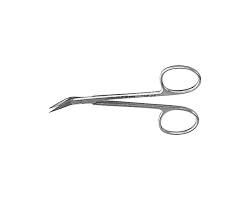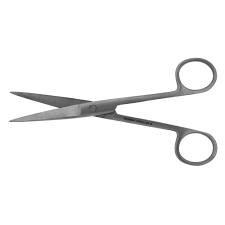In the realm of surgical instruments, precision is paramount. Tools designed for specific tasks can make all the difference in a successful procedure. Among these specialized instruments are Converse scissors, Nasal scissors, and Nasal angle scissors. Each serves a unique purpose in surgical settings, contributing to both efficiency and safety. This article delves into the characteristics, uses, and importance of these instruments, shedding light on their significance in the medical field.
Understanding Surgical Scissors: An Overview
Surgical scissors are fundamental tools in any operating room, used for cutting and dissecting tissues with precision. They come in various shapes and sizes, each tailored for specific surgical procedures. The design of surgical scissors includes blades that can be straight, curved, angled, or microserrated, depending on the intended use. Handles are typically finger-ring style for ergonomic handling and control.
Converse Scissors: Precision in Delicate Procedures
Converse scissors, also known as Converse angle scissors, are named after their distinctive angled design. These scissors are characterized by their sharp, curved blades that meet at an oblique angle. The angled configuration allows surgeons to access and trim tissues in hard-to-reach areas with enhanced visibility and maneuverability.
Uses of Converse Scissors:
- Dental Surgery: Converse scissors are commonly used in dental procedures for precise cutting in tight oral spaces.
- Ophthalmic Surgery: They are invaluable in eye surgeries, especially for delicate maneuvers around the eyeball.
- Plastic Surgery: Surgeons rely on Converse scissors for intricate tissue shaping and trimming in cosmetic procedures.
The ergonomic design of Converse scissors minimizes hand fatigue during prolonged surgeries, making them indispensable in specialties that demand meticulous control and accuracy.
Nasal Scissors: Tailored for Nasal Procedures
Nasal scissors, as the name suggests, are specialized instruments designed for nasal surgeries and procedures involving the nasal passages. These scissors feature delicate, slender blades that are typically straight or slightly curved. The blades may be rounded or pointed, depending on the specific application.
Applications of Nasal Scissors:
- Rhinoplasty: Surgeons use nasal scissors to trim and shape nasal cartilage and tissues during aesthetic and reconstructive nasal surgeries.
- Septoplasty: They play a crucial role in septal surgery, assisting in the precise removal of deviated cartilage and tissue.
- Endoscopic Sinus Surgery: Nasal scissors aid in cutting and removing polyps and diseased tissue in the sinus cavities.
The lightweight design and fine tips of nasal scissors facilitate intricate maneuvers within the narrow confines of the nasal cavity, ensuring minimal trauma and optimal surgical outcomes.
Nasal Angle Scissors: Versatility in Nasal and Ear Surgery
Nasal angle scissors, also referred to as angled nasal scissors, are specialized instruments featuring angled blades that facilitate enhanced visibility and access during nasal and ear surgeries. These scissors are characterized by their sharp, fine tips and ergonomic handles for precise control.
Utilization of Nasal Angle Scissors:
- Otorhinolaryngology (ENT) Surgery: Surgeons use nasal angle scissors for delicate procedures involving the nasal septum, turbinates, and ear canal.
- Facial Plastic Surgery: They are instrumental in reshaping nasal structures and performing intricate corrections.
The angled design of nasal angle scissors allows surgeons to navigate anatomical curves and corners effectively, reducing the risk of tissue damage and optimizing surgical precision.

Importance of Choosing the Right Surgical Scissors
In surgical practice, selecting the appropriate scissors is crucial for achieving optimal outcomes and ensuring patient safety. Factors to consider when choosing surgical scissors include:
- Blade Design: Straight, curved, or angled blades tailored to the procedure requirements.
- Material and Durability: High-quality stainless steel for sharpness and longevity.
- Ergonomics: Comfortable finger-ring handles for precise control and reduced hand fatigue.
Surgeons undergo specialized training to master the use of surgical scissors effectively, ensuring meticulous execution of procedures while prioritizing patient welfare.
Advances in Surgical Technology and Techniques
The evolution of surgical instruments, including Converse scissors, Nasal scissors, and Nasal angle scissors, mirrors advancements in surgical techniques and technology. These instruments have evolved to meet the growing demands of minimally invasive procedures, where precision and minimal tissue trauma are paramount.
Minimally Invasive Surgery (MIS):
- Laparoscopy and Endoscopy: Surgical scissors play a crucial role in minimally invasive techniques, allowing surgeons to perform complex procedures through small incisions.
- Robot-Assisted Surgery: Robotic surgical systems incorporate advanced scissors with enhanced maneuverability and precision, improving surgical outcomes and recovery times.
The integration of these specialized scissors into advanced surgical platforms underscores their role in shaping the future of surgical practice, where technology and precision converge to benefit patient care.
Conclusion
Converse scissors, Nasal scissors, and Nasal angle scissors are indispensable tools in the arsenal of surgical instruments. Their specialized designs cater to the intricate demands of various medical specialties, facilitating precise tissue manipulation and surgical outcomes. As technology advances and surgical techniques evolve, the role of these instruments remains pivotal in achieving surgical success and patient satisfaction. Surgeons and healthcare professionals continue to rely on these precision tools to navigate complex anatomical structures with confidence and expertise, underscoring their enduring significance in modern healthcare practices.
In conclusion, the journey of these surgical scissors—from their historical development to their current indispensable status—highlights their integral role in advancing surgical precision and patient care worldwide.
